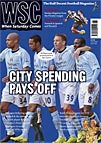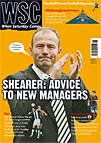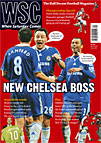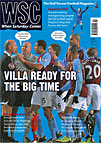 Dear WSC
Dear WSC
AFC Wimbledon fan Aled Thomas (Letters, WSC 267) bemoans people not knowing what to call his club. He would have enjoyed this exchange on Talksport on a recent Saturday when they decided to venture south of the Premier League, for a change. Ian Danter: “AFC Wimbledon could gain promotion to the Conference today.” Micky Quinn: “Is that the original club?” Danter (hesitantly): “Yes.” Quinn: “Do they still play at Plough Lane?” Why so knowledgeable?
Glyn Berrington, Brierley Hill
Search: ' Stoke City'
Stories
 Jonathan Paxton recalls how an almost famous season for Stoke was ruined by manager and star player falling out
Jonathan Paxton recalls how an almost famous season for Stoke was ruined by manager and star player falling out
“All teams have their era,” my Grandad often tells me. “It’s just that Stoke’s came between 1939 and 1945.” Most biographies of Adolf Hitler focus on stronger crimes against humanity ahead of denying Stoke City their chance of winning silverware but few in the Potteries would argue that the club’s golden generation lost their best years to the war. In 1938-39 the team managed by former player Bob McGrory finished seventh playing some of the finest football in the country. Freddie Steele scored 26 goals at centre-forward, centre-half Neil Franklin was just out of the youth team and, on the right wing, the Potters had Hanley-born England superstar Stanley Matthews who made his debut aged 17 in 1932. Fans were rightly optimistic.
 Ian Plenderleith examines a selection of websites that remember stadiums from football's past
Ian Plenderleith examines a selection of websites that remember stadiums from football's past
There’s an online version of a book filled with aerial pictures of Lost Football Stadiums that shows a bird’s eye view on the sites of demolished grounds. Some are shockingly prosaic views of housing projects, industrial estates and supermarkets. To many of us, it seems like sacrilege not just to demolish a ground, but also to leave little or no evidence that it ever existed. Scunthorpe’s Old Showground is nothing but a memorial brick in a wall, while the flats of Leicester’s Filbert Village no more resemble a rural settlement then they do a former football stadium. The preservation of Highbury’s façade is an honourable exception.
 Everton and the BNP recently clashed over the timing of a party campaign. Mark O'Brien looks at how the police deal with disruptons to the matchday routine
Everton and the BNP recently clashed over the timing of a party campaign. Mark O'Brien looks at how the police deal with disruptons to the matchday routine
From the England team’s Nazi salute in 1938 to the T-shirts worn by Robbie Fowler and Steve McManaman in support of striking dockers, politics has frequently exerted an influence on football. That convergence caused quite some concern on Merseyside when the British National Party announced recently that they planned to conduct a leafleting campaign in Liverpool city centre on the afternoon of Saturday March 14, the same afternoon as Everton were scheduled to play host to Stoke City in the Premier League.Tranmere were at home to Huddersfield on the same afternoon, while Liverpool supporters would also be returning from their early game at Old Trafford, and according to Chief Superintendent Steve Watson of Liverpool North: “If they had all taken place at the same time it would have placed extraordinary pressures on demand and would have affected the ability to police those events effectively.”
 Wigan throw it away as Preston capture the title, by Mark Barr
Wigan throw it away as Preston capture the title, by Mark Barr
The long-term significance
This was the season that revived two traditional Lancashire clubs. Preston returned to the second level after a nineteen year absence, while runners-up Burnley had spent only two years outside the lower divisions during the same period. Both clubs have remained in the Championship, with Preston qualifying for the playoffs twice. This season Burnley’s victories over Chelsea and Arsenal have take them to their first major cup semi final since 1982-83.